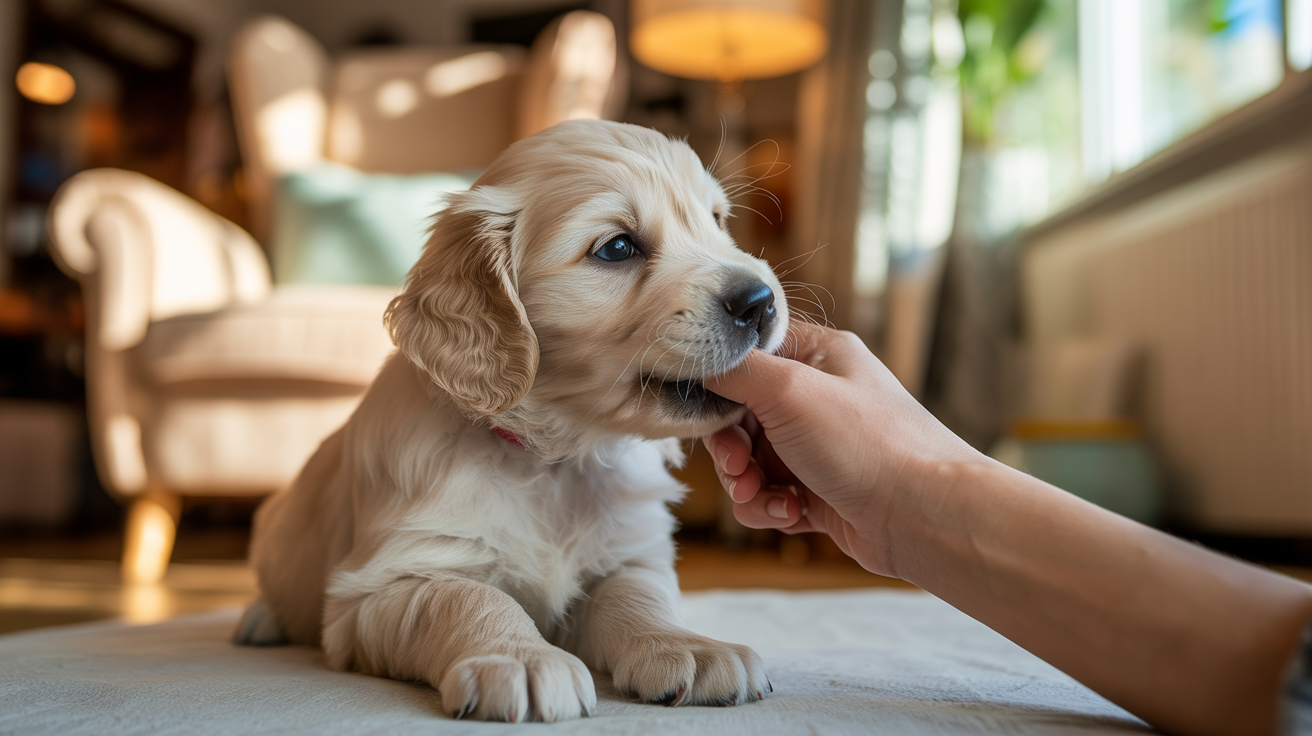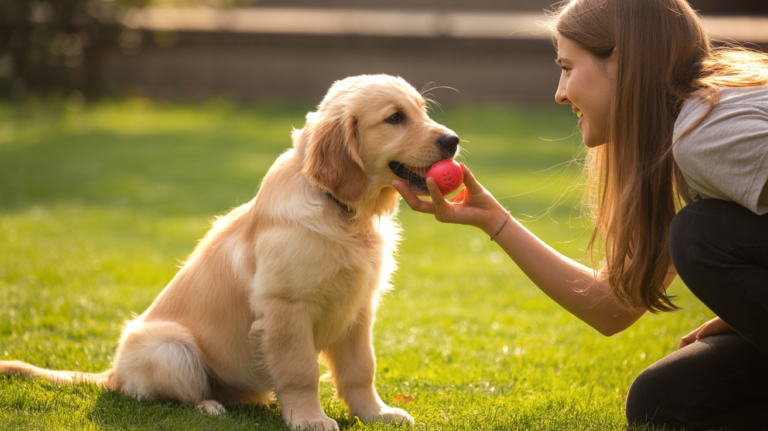5 Quick Tips to Stop Puppy Biting for Good
If you’ve recently welcomed a fluffy new puppy into your home, you’ve probably experienced those razor-sharp needle teeth firsthand.
Your hands might be covered in tiny scratches, your clothes have holes in them, and you’re wondering if you adopted a puppy or a tiny piranha. Don’t worry—you’re not alone, and more importantly, you haven’t failed as a puppy parent.
Puppy biting is one of the most common frustrations new dog owners face. Those adorable little fur babies can turn into nippy monsters during playtime, leaving you wondering if this behavior will ever stop.
The good news? Puppy biting is completely normal, and with the right approach, you can teach your puppy to keep those teeth to themselves much faster than you might think.
Understanding why puppies bite is the first step to solving the problem. Puppies explore the world with their mouths—it’s their primary way of learning about their environment.
They’re also teething, which means their gums are uncomfortable and chewing provides relief. Additionally, biting and mouthing is how puppies play with their littermates.
When you bring a puppy home, they don’t automatically understand that human skin is much more sensitive than their siblings’ fur-covered bodies.
The beautiful truth is that puppy biting isn’t a behavior problem—it’s a training opportunity. With consistency, patience, and the five proven strategies we’re about to share, you can see significant improvement in just days to weeks.
These aren’t complicated techniques that require expensive equipment or professional training sessions. They’re simple, effective methods that any puppy owner can implement starting today.
Ready to reclaim your hands and sanity? Let’s dive into the five quick tips that will stop puppy biting for good.
Quick Overview: 5 Proven Tips to Stop Puppy Biting
Before we explore each strategy in depth, here’s your quick reference guide to stopping puppy biting:
- Redirect with appropriate chew toys – Give your puppy acceptable outlets for their chewing needs
- Use consistent “no bite” cues – Establish clear communication about what’s off-limits
- Apply immediate positive reinforcement – Reward gentle behavior the moment it happens
- Schedule regular puppy socialization – Let other puppies teach bite inhibition naturally
- Teach gentle play and mouth awareness – Help your puppy understand their bite pressure
Now let’s break down each tip with actionable steps you can start using today.
Tip 1: Redirect with Appropriate Chew Toys
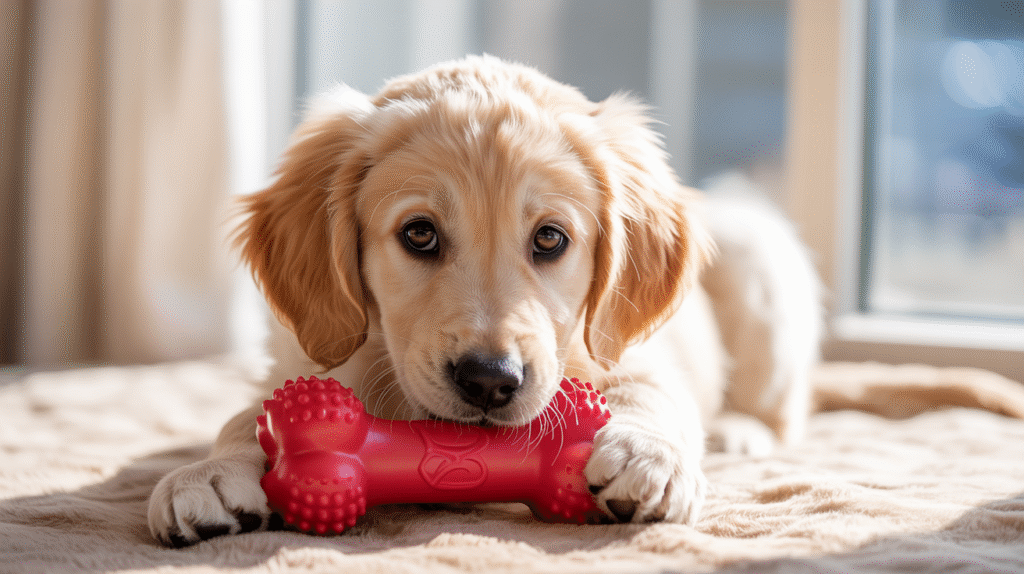
The foundation of stopping puppy biting is giving your puppy appropriate alternatives. You can’t expect your puppy to stop biting entirely—they need to chew. Your job is to teach them what they can and cannot bite.
The Science Behind Redirection: Puppies have a biological need to chew, especially during the teething phase from 3-8 months.
Their baby teeth are falling out and adult teeth are coming in, causing discomfort and itchiness in their gums.
Chewing provides natural pain relief and helps loosen those baby teeth. By redirecting to appropriate toys, you satisfy this need while teaching boundaries.
Step-by-Step Instructions:
- Keep toys accessible everywhere. Place puppy-safe chew toys in every room where your puppy spends time. You should be able to grab a toy within seconds, no matter where you are.
- The instant your puppy’s teeth touch your skin, say “uh-oh” or “no” in a calm (not angry) voice and immediately stop all interaction. Go completely still and avoid eye contact.
- Present an appropriate chew toy within 2-3 seconds. Hold it in front of your puppy’s mouth to make it easy for them to grab.
- When your puppy takes the toy, praise enthusiastically! Say “yes!” or “good!” and give them gentle pets or additional praise. This creates a positive association with chewing the right things.
- If your puppy ignores the toy and goes back to biting you, stand up and walk away for 10-15 seconds. This teaches that biting humans = fun ends immediately.
- Return and try again. Consistency is everything. You may need to repeat this 20+ times in a single play session initially.
Best Toy Choices for Redirection:
- Rubber toys (Kong, Nylabone Puppy range)
- Rope toys for tugging
- Soft plush toys for carrying
- Teething-specific toys that can be frozen
- Puzzle toys filled with treats
- Different textures to maintain interest
Mistakes to Avoid:
Don’t use old shoes or clothes as toys. Your puppy can’t distinguish between your old sneaker and your new one. Every item should either be always okay to chew or always off-limits.
Don’t jerk your hand away quickly. Fast movements trigger prey drive and make biting more exciting. Instead, go still and boring.
Don’t use the same toy every time. Rotate through different toys to keep them interesting. A puppy who’s bored with their toys will go back to biting you.
Don’t skip the praise. Many owners remember to say “no” but forget to reward when their puppy makes the right choice. The positive reinforcement is more important than the correction.
Pro Tip: Keep a toy in your pocket during high-energy play times. When your puppy gets mouthy, you can produce the toy like magic and redirect before they even make contact with your skin.
Tip 2: Use Consistent “No Bite” Cues
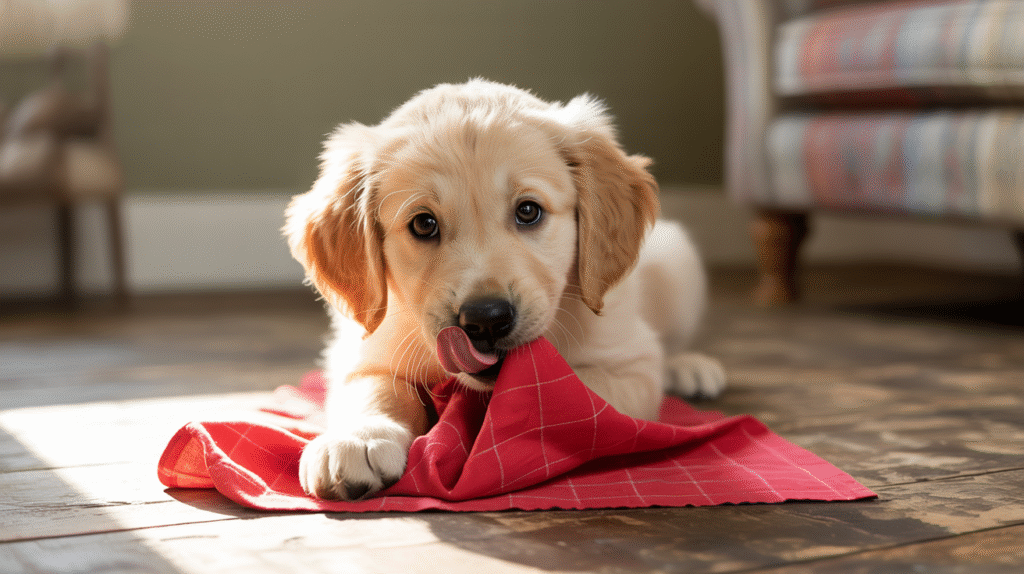
Consistency is the secret ingredient to successful puppy training. Your puppy needs to hear the same message from every family member, every single time.
The Logic Behind Consistent Cues: Dogs learn through repetition and association. If you say “ouch” one time, “no” another time, “stop that” the next time, and sometimes laugh it off, your puppy receives mixed signals.
Consistent verbal and physical cues help your puppy understand exactly what you want them to stop doing.
Step-by-Step Instructions:
- Choose your cue word or sound. Common options include “no bite,” “ouch,” “uh-oh,” or even a high-pitched yelp that mimics how puppies communicate with each other. Pick one and stick with it.
- Use the cue immediately when teeth touch skin—not before, not after. Timing is critical. Your puppy needs to connect the cue with the exact moment of biting.
- Pair the verbal cue with a physical response. The moment you say your cue word, stop all movement and interaction. Turn your head away, cross your arms, and become completely uninteresting.
- Hold the “freeze” for 5-10 seconds. This brief timeout teaches your puppy that biting causes all the fun to stop.
- Resume play only after your puppy calms down. If they’re still in a frenzy, wait a bit longer. You want to reward calm behavior, not continued excitement.
- Get everyone on board. Every family member, visitor, and dog sitter needs to use the same cue and response. Write it down if necessary. Inconsistency will double or triple your training time.
The Yelp Method: Many trainers recommend using a high-pitched “ow!” or yelp sound, similar to what a puppy’s littermate would make. This mimics natural communication and can be very effective.
How to do it:
- When bitten, say “OW!” or “YIPE!” in a high, sharp voice
- Immediately stop playing and ignore your puppy
- Wait 10-15 seconds before resuming interaction
- If biting continues, leave the room entirely
Important note: This method works well for many puppies but can overstimulate some. If your puppy gets MORE excited when you yelp, switch to a calm, firm “no” instead.
Mistakes to Avoid:
Don’t yell or get angry. Harsh reactions can frighten your puppy or, counterintuitively, make them think you’re playing. Stay calm and matter-of-fact.
Don’t physically punish your puppy. Never hit, slap, or tap your puppy’s nose. This damages trust, can cause fear-based aggression, and simply doesn’t work. Positive reinforcement is far more effective.
Don’t give mixed messages. If biting during play is sometimes funny and sometimes forbidden, your puppy will be confused. Be consistent 100% of the time.
Don’t continue playing. Some owners say “no” but keep playing, which teaches the puppy that the word “no” doesn’t actually mean anything. Your actions must match your words.
Real-Life Application: Imagine you’re playing tug-of-war and your puppy gets overexcited and nips your hand. Immediately say “ouch,” drop the toy, stand up, cross your arms, and turn away. Count to 15 silently.
Then, turn back around. If your puppy is calm, say “gentle” and resume play. If they immediately nip again, repeat the process. After three strikes, end playtime completely and walk away.
Tip 3: Apply Immediate Positive Reinforcement
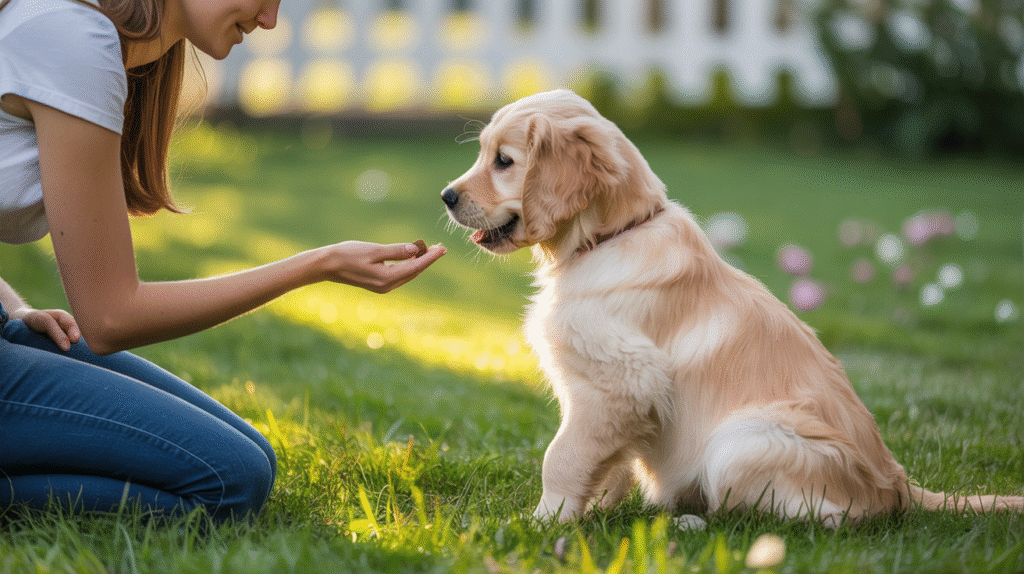
While stopping biting is important, teaching what you want your puppy TO do is even more powerful. Positive reinforcement creates lasting behavioral change faster than punishment ever will.
The Science of Positive Reinforcement: Puppies (like all animals) repeat behaviors that result in rewards and avoid behaviors that result in nothing.
When you reward gentle behavior immediately and consistently, your puppy learns that keeping teeth off skin is much more beneficial than biting.
The key word here is “immediately”—rewards must come within 1-2 seconds of the desired behavior for your puppy to make the connection.
Step-by-Step Instructions:
- Identify and mark gentle behavior instantly. The moment your puppy licks instead of bites, plays without teeth, or pulls their mouth away, say your marker word (“yes!” or “good!”) or use a clicker.
- Follow with a high-value reward within 2 seconds. This could be a small training treat, enthusiastic praise, a quick game, or a favorite toy—whatever your puppy loves most.
- Name the behavior. As your puppy gets better, start saying “gentle” or “easy” right before they interact gently. This builds an association between the word and the action.
- Gradually increase expectations. At first, reward any moment without biting. Then, only reward longer periods of gentle play. Finally, only reward the absolute best gentle behavior.
- Catch your puppy being good. Don’t only pay attention when your puppy is misbehaving. Actively look for moments when they’re playing nicely or chewing appropriate toys, and reward those too.
Setting Up Success:
Short training sessions: Practice for 5-10 minutes at a time when your puppy is calm, not during their “zoomies” or overtired moments. A calm puppy can learn; a frantic puppy cannot.
Use high-value treats: Regular kibble won’t cut it for this level of training. Use small pieces of chicken, cheese, hot dog, or special training treats that your puppy absolutely loves.
Practice “gentle” with treats: Hold a treat in your closed fist. Only open your hand when your puppy licks or touches gently (not nibbling or biting). This teaches mouth control in a low-pressure situation.
Reward calm greetings: When you first come home or enter a room, ignore jumping and mouthing. The instant your puppy has all four paws on the floor and isn’t biting, give attention and treats. This prevents excited biting during greetings.
Mistakes to Avoid:
Don’t delay rewards. Even 5 seconds is too long. Your puppy won’t connect the reward to the gentle behavior if too much time passes. Keep treats in your pocket for instant access.
Don’t use only verbal praise. While saying “good dog” is nice, it’s not motivating enough for most puppies. Combine verbal praise with physical rewards (treats, play, petting).
Don’t reward mixed behavior. If your puppy is gentle for a moment but then nips, don’t give the treat “for trying.” You’ll accidentally reward the nipping. Wait for a truly gentle moment.
Don’t forget to phase out treats eventually. Once your puppy is consistently gentle, start rewarding intermittently (not every time) and replace some treats with life rewards like going outside, starting a game, or getting their leash for a walk.
Training Game – “Gentle Takes”: This exercise teaches your puppy to control their mouth:
- Hold a treat in your closed hand
- Let your puppy sniff and investigate
- If they bite, paw, or nibble—close your hand completely and look away
- Add the word “gentle” right before opening your hand
- Repeat 10-15 times per session
- The moment they lick gently or back away—open your hand and let them have the treat
Within a week, most puppies understand that gentle mouth = treat, while biting = nothing.
Tip 4: Schedule Regular Puppy Socialization
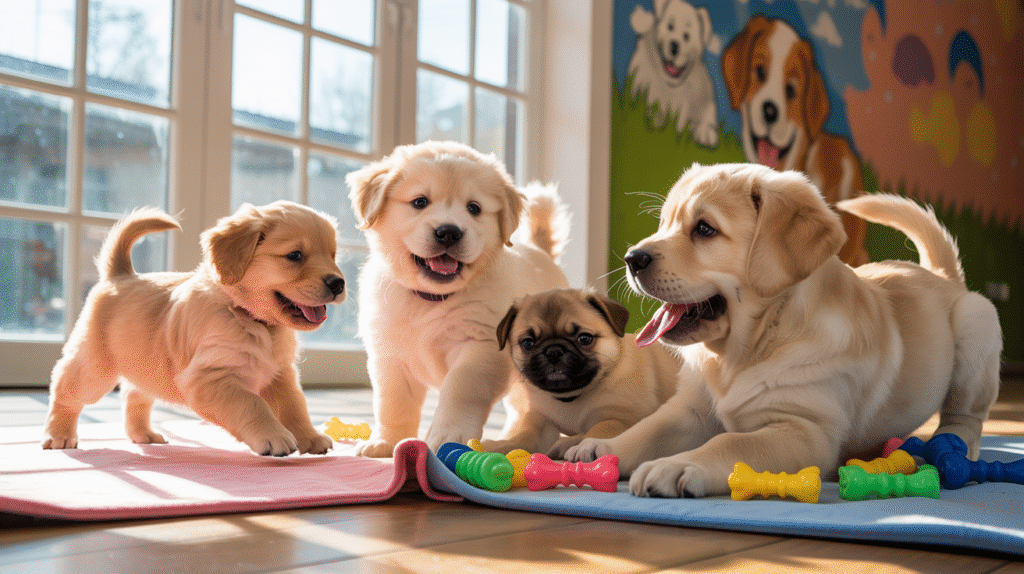
Here’s a secret: you don’t have to teach your puppy everything yourself. Other puppies are incredibly effective teachers when it comes to bite inhibition.
Why Socialization Works: In a normal litter, puppies teach each other boundaries through play. When one puppy bites too hard, the bitten puppy yelps and stops playing. The biter quickly learns to control their jaw pressure or playtime ends.
When puppies leave their litters too early (before 8 weeks), they miss crucial lessons in bite inhibition. Organized puppy socialization recreates these important learning opportunities.
Step-by-Step Instructions:
- Find appropriate socialization opportunities. Look for:
- Puppy kindergarten classes (usually for puppies 8-16 weeks)
- Puppy play groups at training facilities
- Veterinarian-hosted puppy socials
- Trusted friends with vaccinated, friendly puppies of similar age and size
- Verify safety requirements. Ensure all puppies are up-to-date on age-appropriate vaccinations. While socialization is critical, it must be done safely.
- Schedule regular sessions. Aim for 2-3 socialization opportunities per week during the critical period (8-16 weeks). Even once weekly makes a significant difference.
- Observe the play. Watch how other puppies react when your puppy bites too hard. You’ll see them yelp, turn away, or stop playing—natural consequences that teach bite inhibition.
- Don’t intervene too quickly. Unless a puppy is truly scared or the play is becoming too rough, let the puppies work it out. They’re learning valuable skills.
- Apply lessons at home. Notice what works when other puppies correct your pup, and mimic those responses during your interactions.
What Good Puppy Play Looks Like:
- Lots of play bows and bouncy movements
- Take turns being “on top” or “in charge”
- Brief pauses or role reversals
- Matching energy levels
- Self-handicapping (bigger puppy plays gently with smaller one)
- Coming back for more after corrections
What to Watch For:
- One puppy constantly on their back looking scared
- Relentless chasing without breaks
- One puppy trying to hide or escape
- Stiff body language or raised hackles
- Continuous crying or yelping
Socialization Beyond Puppies: While puppy playgroups are ideal, your puppy can also learn from:
- Well-mannered adult dogs (who are patient with puppies)
- Different people (children, adults, seniors)
- Various environments (parks, pet stores, outdoor cafes)
- Different surfaces, sounds, and experiences
Mistakes to Avoid:
Don’t skip socialization due to fear. Some owners worry about disease transmission and keep puppies isolated until fully vaccinated. However, the critical socialization window closes around 16 weeks.
The American Veterinary Society of Animal Behavior states that behavioral issues from lack of socialization kill more dogs than infectious diseases. Socialize safely by choosing clean environments and requiring vaccines.
Don’t only socialize with adult dogs. While a well-behaved adult dog can model good behavior, puppies learn bite inhibition best from other puppies who provide immediate, appropriate feedback.
Don’t force interactions. If your puppy is scared or overwhelmed, don’t push them into play. Let them observe from a distance and approach when ready. Forced socialization can backfire.
Don’t confuse socialization with exercise. Socialization is about positive experiences and learning, not just burning energy. A 20-minute quality play session is better than an hour of chaotic, unsupervised play.
Bonus Benefit: Well-socialized puppies become confident, friendly adult dogs who are comfortable in various situations. You’re not just solving the biting problem—you’re building a well-adjusted companion for life.
Tip 5: Teach Gentle Play and Bite Inhibition
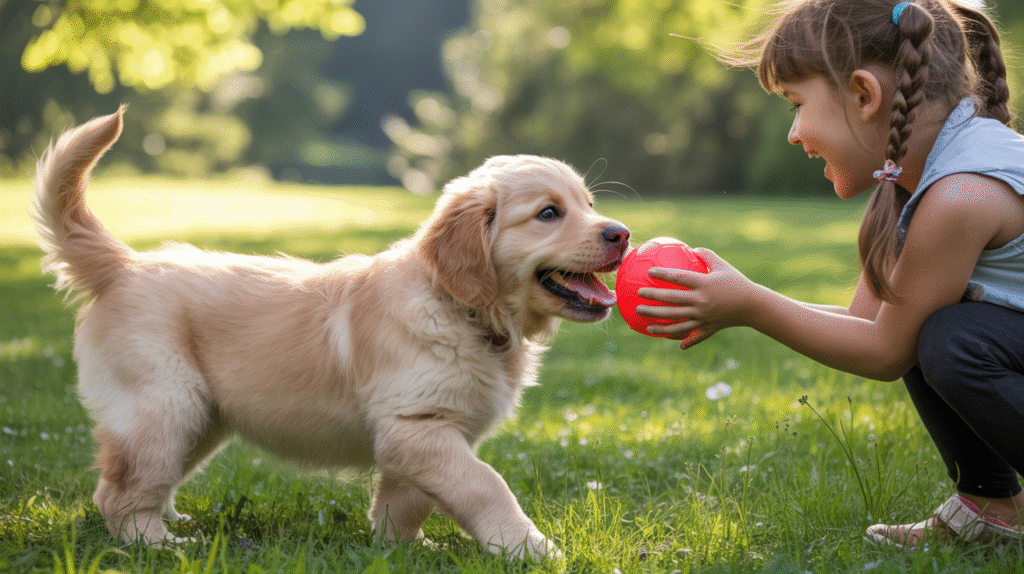
The ultimate goal isn’t to stop your puppy from ever using their mouth during play—it’s to teach them to control the pressure of their bite and understand when mouthing is appropriate versus inappropriate.
Understanding Bite Inhibition: Bite inhibition is the learned skill of controlling jaw pressure. A dog with good bite inhibition can play with their mouth gently, take treats softly, and if they ever bite in fear or pain as an adult, they’re far less likely to cause serious injury. This is a critical life skill that’s best taught during puppyhood.
Step-by-Step Instructions:
Phase 1: Reduce Bite Pressure (Weeks 8-10)
- Allow gentle mouthing during play—yes, you read that right. At this stage, you’re teaching softness, not stopping all mouthing.
- Set a pressure threshold. Decide what level of pressure is acceptable. Most trainers suggest allowing contact that doesn’t hurt.
- When pressure exceeds your threshold, immediately yelp “OW!” loudly, pull your hand away, and stop all interaction for 20-30 seconds.
- Resume play. Give your puppy another chance. If they mouth more gently, praise and continue playing.
- Track improvement. Over several days, you should notice softer and softer contact. Once your puppy consistently mouths gently, move to Phase 2.
Phase 2: Reduce Frequency (Weeks 10-14)
- Now that mouthing is gentle, start reducing how often it happens. Allow fewer and fewer mouthing incidents during play.
- When any mouthing occurs (even gentle), say “no mouth” or “off,” remove your hand, and pause play.
- Reward teeth-free play heavily with praise, treats, and continued play.
- Gradually increase the duration of play without any mouthing before giving rewards.
Phase 3: Eliminate Mouthing (Weeks 14+)
- By now, mouthing should be rare. When it does happen, end play immediately by standing up and walking away.
- Only play when teeth stay off skin. This is non-negotiable now.
- Teach “gentle” as a command. Say “gentle” and reward any soft, licking contact. Over time, your puppy will learn that “gentle” means “soft mouth only.”
Teaching “Take It” and “Drop It”: These commands support gentle play:
“Take It” for Gentle Taking:
- Hold a treat in your hand
- Say “gentle” or “easy”
- Offer the treat
- If your puppy snatches or bites fingers, close your hand and say “uh-oh”
- Try again
- When they take it gently (even slightly), say “yes!” and let them have it
- Practice daily until taking treats gently is automatic
“Drop It” for Safety:
- During play with a toy, say “drop it”
- Offer a treat at their nose
- When they drop the toy to get the treat, say “yes!”
- Give the treat AND the toy back
- This teaches that “drop it” doesn’t mean the fun ends
Interactive Gentle Play Games:
Tug-of-War (Controlled):
- Use a long rope toy so hands stay far from teeth
- Establish that play stops if teeth touch skin
- Teach “take it” to start and “drop it” to end
- Keep sessions short (2-3 minutes)
- Let your puppy “win” sometimes to keep it fun
Fetch:
- Teaches that bringing things to you = good
- Rewards running energy out
- Practice gentle “give” when returning the toy
- If your puppy mouths you during exchanges, stop the game
Mistakes to Avoid:
Don’t skip Phase 1. Many owners try to stop all mouthing immediately, which doesn’t teach bite pressure control. If your dog ever bites in self-defense as an adult, you want them to have learned gentleness first.
Don’t wrestle with hands. Using your hands as play toys teaches your puppy that hands are for biting. Always use actual toys during play.
Don’t play when your puppy is overtired. Puppies need 15-20 hours of sleep daily. Overtired puppies become nippy, cranky, and unable to learn. If your puppy suddenly gets bitey, they probably need a nap.
Don’t ignore warning signs of overstimulation. These include dilated pupils, ignoring cues they normally follow, frantic behavior, and inability to settle. End play before your puppy reaches this state.
Special Consideration – Clothes and Ankles: Some puppies become obsessed with biting clothes, shoelaces, or ankles during movement:
- Stop moving immediately when this happens
- Don’t drag your puppy or kick (even gently)
- Redirect to a toy
- If it continues, use a baby gate or leash to create boundaries
- Practice “leave it” command with clothing items
- Ensure your puppy gets enough exercise and mental stimulation
Common Mistakes Puppy Parents Make
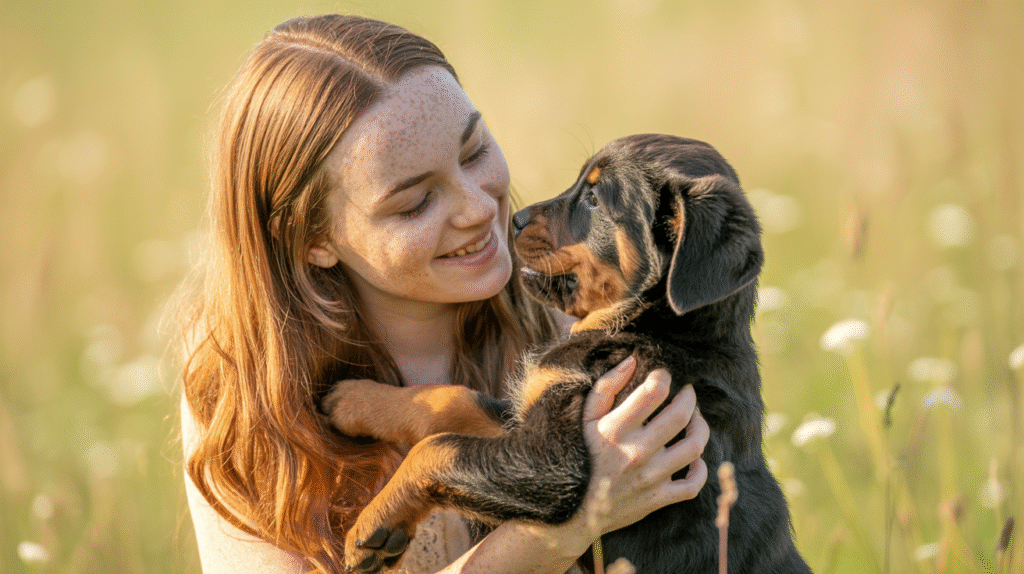
Even with the best intentions, many puppy owners accidentally encourage biting behavior. Avoid these common pitfalls:
Playing Too Rough Wrestling, pushing your puppy around, or playing chase games where you’re “prey” encourages biting and overstimulation. Keep play calm and controlled, especially during the training phase.
Inconsistent Rules Between Family Members If dad lets the puppy mouth during play but mom doesn’t, your puppy receives mixed messages. Family meetings about training rules aren’t optional—they’re essential.
Rewarding Biting with Attention Any attention—even negative—can be rewarding to a puppy. If you shriek, laugh, or make a big fuss when bitten, you might be accidentally encouraging the behavior. Stay calm and boring when correcting biting.
Not Providing Enough Mental Stimulation A bored puppy is a bitey puppy. Ensure your puppy gets age-appropriate exercise, puzzle toys, training sessions, and mental enrichment throughout the day.
Forgetting the Sleep Schedule Puppies turn into tiny terrors when overtired. Enforce nap times (usually after 1 hour of awake time). Many puppy biting problems disappear with adequate sleep.
Using Hands as Toys Even gentle hand-playing teaches your puppy that hands are acceptable chew toys. Always redirect to appropriate toys instead.
Punishment Instead of Teaching Yelling, hitting, or using punishment-based methods damages your bond and can create fear-based aggression. Focus on teaching what TO do, not just what NOT to do.
Giving Up Too Soon Puppy biting won’t stop overnight. Most puppies need 2-6 weeks of consistent training to show significant improvement and 4-6 months to fully grow out of biting behaviors. Consistency wins.
Frequently Asked Questions
At what age do puppies naturally stop biting? Most puppies significantly reduce biting between 4-6 months as their adult teeth come in and teething discomfort decreases. However, without training, some dogs continue mouthy behavior into adulthood. The good news is that with consistent training using the methods above, you should see major improvement within 2-4 weeks, regardless of age.
What are the best chew toys for teething puppies? Look for puppy-specific products that are softer than adult dog toys. Top choices include:
- KONG Puppy (soft rubber, can be frozen with treats inside)
- Nylabone Puppy Chew Toys (designed for baby teeth)
- Rope toys for tugging and chewing
- Chilly Bone or other freezable teethers
- Rubber toys with different textures
- Benebone Puppy (wishbone shape, flavored)
Avoid hard toys like antlers, bones, or hard nylon toys that can damage puppy teeth. Supervise with plush toys to ensure your puppy doesn’t ingest stuffing.
My puppy gets more aggressive when I say “ow” or yelp. What should I do? About 20-30% of puppies get MORE excited by high-pitched sounds, treating your yelp as an invitation to play harder. If this describes your puppy, switch to a calm, firm “no bite” or simply freeze and ignore without making any sound. The loss of interaction (not the verbal cue) is what teaches the lesson.
Is my puppy being aggressive or just playing? True aggression in young puppies is extremely rare. Play biting involves:
- Bouncy, loose body language
- Play bows (front end down, rear up)
- Breaks in the action
- Responding to “ow” or stopping cues (even if slowly)
- Tail wagging (though this alone doesn’t mean friendly)
Concerning signs that warrant professional evaluation:
- Stiff, still body language
- Prolonged, intense staring
- Growling with serious intent (different from play growling)
- Not responding to any stopping cues
- Biting that breaks skin regularly
- Guarding resources aggressively
When in doubt, consult a certified dog trainer or veterinary behaviorist.
Should I use bitter spray or other deterrents? Bitter apple spray can help protect furniture and hands as a secondary tool, but it shouldn’t be your primary training method. Many puppies don’t mind the taste, and it doesn’t teach your puppy what they SHOULD do. Use it alongside the training methods above, not instead of them.
How can I stop my puppy from biting my children? Puppies often view children as playmates and can be extra mouthy with kids. Safety tips:
- Always supervise puppy-child interactions
- Teach children to be “trees” (still and boring) when the puppy gets mouthy
- Don’t allow children to run, squeal, or play chase
- Give children treats to reward gentle behavior
- Practice all training with adults first, then include children
- Consider tethering your puppy during child interaction so they can’t chase
- Ensure children aren’t accidentally encouraging rough play
My puppy only bites at certain times. Why? Patterns often reveal the trigger:
- Morning/evening: overtiredness or excess energy
- During walks: excitement or frustration
- When guests arrive: overstimulation
- After meals: zoomies or food-motivated energy
- During attention-seeking: learned behavior that gets results
Identify the pattern, then address the root cause (more exercise, enforced naps, calming protocols) while continuing training.
When to Seek Professional Help
While puppy biting is normal and usually resolves with consistent training, certain situations call for professional intervention:
Signs You Need a Professional Trainer:
- Your puppy is over 6 months and biting is getting worse, not better
- Biting is causing injuries (broken skin, bruising)
- Your puppy shows other concerning behaviors (growling when touched, guarding food aggressively, extreme fearfulness)
- You’ve been consistent with training for 4-6 weeks with no improvement
- Your puppy’s biting seems aggressive rather than playful
- You feel unsafe or afraid of your puppy
- Your puppy was separated from their litter before 8 weeks old and shows poor bite inhibition
Finding the Right Professional: Look for:
- Certified Professional Dog Trainer (CPDT-KA)
- Certified Applied Animal Behaviorist (CAAB)
- Veterinary Behaviorist (DACVB)
- Trainers who use positive reinforcement methods
- Good reviews and references from other clients
Avoid trainers who use:
- Punishment-based methods
- Shock collars or prong collars on puppies
- Alpha/dominance theory
- “Breaking” a dog’s spirit
Medical Considerations: Rarely, excessive biting can indicate:
- Pain from teething complications
- Ear infections or other discomfort
- Neurological issues
- Vision or hearing problems
If your puppy suddenly becomes much more mouthy or shows other signs of illness (lethargy, loss of appetite, crying when touched), schedule a veterinary checkup.
Prevention is Key: The earlier you start training, the easier it is. Puppies are most receptive to learning between 8-16 weeks. If you’re reading this with a young puppy, you’re ahead of the game!
Conclusion: Your Action Plan for Success
Stopping puppy biting doesn’t require magical skills or expensive equipment—it requires consistency, patience, and the right techniques. Let’s recap your action plan:
Starting Today:
- Stock up on appropriate chew toys and place them strategically around your home
- Choose your “no bite” cue and inform all family members
- Keep treats in your pocket for immediate positive reinforcement
- Research puppy socialization opportunities in your area
- Begin teaching “gentle” with the treat exercise
This Week:
- Practice redirection 20+ times daily
- Implement consistent responses from everyone in the household
- Schedule your first puppy socialization session
- Start teaching “take it” and “drop it”
- Ensure your puppy gets adequate sleep (enforced nap times)
This Month:
- You should see significant reduction in biting intensity and frequency
- Continue socialization 2-3 times weekly
- Gradually increase expectations for gentle play
- Phase in intermittent reinforcement (not treating every single time)
- Maintain consistency even when you see improvement
Remember: Puppy biting is a phase, not a permanent personality trait. With the five techniques outlined in this guide, most puppy parents see dramatic improvement within 2-4 weeks. Some puppies learn faster, some slower—but virtually all puppies outgrow biting with proper training.
Stay patient with your little landshark. Those needle teeth will be replaced by adult teeth, the teething phase will pass, and the lessons you’re teaching now will create a gentle, well-mannered adult dog who knows how to control their mouth.
Your Turn! What’s been your biggest challenge with puppy biting? Which of these five tips are you most excited to try? Share your experiences in the comments below—your story might help another frustrated puppy parent realize they’re not alone!
Found this helpful? Pin this guide to your “Puppy Training” board so you can reference it whenever those sharp teeth make an appearance. Share it with other new puppy parents who are struggling with the same challenges.
Related Posts You’ll Love:
- Puppy Training Essentials: Your Complete First-Year Guide
- How to Potty Train Your Puppy in 7 Days
- Best Puppy Teething Toys: Reviews and Recommendations
- Puppy Socialization Checklist: 100 Things to Experience
- Understanding Puppy Body Language: What Your Dog Is Telling You
Remember: Every gentle interaction is a training success. Every toy redirection is progress. Every moment of soft mouth is worth celebrating. You’re not just stopping puppy biting—you’re building a lifetime of trust and communication with your furry best friend.
Now go reclaim those hands and enjoy your adorable (less bitey) puppy!
Disclaimer: This article provides general training advice and is not a substitute for professional dog training or veterinary behaviorist consultation. Always consult with qualified professionals if you have concerns about your puppy’s behavior.
SOURCES & FURTHER READING
- American Veterinary Medical Association (AVMA): https://www.avma.org
- PetMD: “How to Stop Puppy Biting” https://www.petmd.com/dog/puppy-biting
- Veterinary Partner (VIN): https://veterinarypartner.vin.com
- ASPCA Dog Behavior Resources: https://www.aspca.org/pet-care/dog-care/dog-behavior-training

